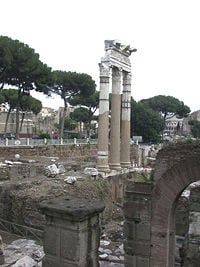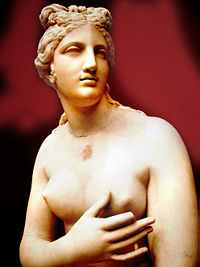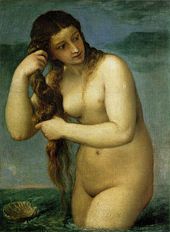Venus (mythology)
Venus was a major Roman goddess principally associated with love and beauty and fertility. She was considered the ancestor of the Roman people by way of its legendary founder, Aeneas, and played a key role in many Roman religious festivals and myths. Since many of the figures of Roman mythology were largely appropriated from the Greek tradition, Venus is virtually identical to Aphrodite, the goddess of love in the Greek pantheon.
Origins
Venus carries on a tradition of eroticized female divinities featured in the legends of surrounding Indo-European and Near Eastern mythological systems, including Inanna among the Sumerians, Ishtar among the Mesopotamians, Hathor in the Ancient Egypt, Ashtart or Astarte among the Syro-Palestinians, Turan among the Etruscans, and the Ushas, Vedic goddesses of the dawn. Like the Roman Venus and the Greek Aphrodite, each of these goddesses is described as a beautiful female with jurisdiction over love, sexuality, fertility, and sometimes even sacred prostitution. It is likely that Aphrodite, and subsequently Venus, borrowed significant aspects from each of these goddesses. Venus bears a particular linguistic link to the Ushas, who were ascribed a Sanskrit epithet of vanas- referring to "loveliness", "longing" or "desire". Vanas-" is cognate to Venus, suggesting that Venus was linked to the Proto-Indo-European linguistic tradition via the reconstructed stem *wen- "to desire"[1].
Mythology
The story of Venus' birth, borrowed directly from the Greeks, explains that she was born from the foam of the sea shore. This miraculous creation resulted after Saturn castrated his father, the supreme sky god Caelus (equivalent to the Greek Uranus. It is said that Saturn cut off Caelus' genitals and threw them into the sea. As the genitals drifted over the water, the blood and/or semen that issued forth from the severed flesh set in motion the growth of the child who would become Venus.
According to Roman Mythology, Venus was the wife of the dour and unsightly Vulcan, with whom she was perpetually unsatisfied. Venus had no children with Vulcan but her prolific extramarital activities with both gods and mortal men allowed her to mother many offspring nonetheless. Vulcan was often disgusted by her innumerable amorous trysts, and eventually would exact vengeance on Venus and Mars, the god of war and also her favourite lover. Vulcan fashioned a net with unbreakable links and placed it in the bedroom in which the lovers met. The next time Mars and Venus jumped into the bed in the throes of passion, the net fell, ensnaring the lovers. Vulcan proceeded to bring all of the gods together to look upon the scandalous couple and mock them. Once the chains were lifted, Mars promptly fled for safety.
Among Venus's many other children of significance is Aeneas, the legendary Trojan hero who founded the city that would one day become Rome. Aeneas was born by way of Venus' tryst with the mortal Anchises, after she seduced him in the guise of a Phrygian princess, a myth borrowed directly from the Greeks. Legend has it that after Aeneas' death, Venus asked Jupiter to render her son immortal. Jupiter agreed, and after the river god Numicius had cleansed Aeneas of all his mortal parts, Venus anointed him with Ambrosia and Nectar, elevating him to godly status. Since Aeneas is a distant descendant of Romulus and Remus, the mythological founders of Rome, Venus was also considered a divine ancestor of the entire race of Roman people. The Julian family of Rome, most famous for the emperors Julius Caesar and Augustus, also traced its lineage to Aeneas, and therefore to Venus, as well.
Cult
The cult of Venus began in Ardea and Lavinium, Latium. On August 15, 293 B.C.E., her oldest-known temple was dedicated during the Third Samnite War by Quintus Fabius Maximus Gurges. August 18 became a festival called the Vinalia Rustica. It was built with money fined from women who had been found guilty of adultery. It was the oldest temple of Venus in Rome, and was probably situated at the foot of the Aventine Hill near the Circus Maximus. Its dedication day, August 19, was celebrated in the Vinalia Rustica. On April 23, 215 B.C.E., a temple to Venus was dedicated outside the Colline gate on the Capitol, to commemorate the Roman defeat at the Battle of Lake Trasimene.
Venus in her role as the ancestress of the Roman people, a goddess of motherhood and domesticity was celebrated at a festival held in her honor on September 26. As Venus was regarded as the mother of the Julian gens in particular, Julius Caesar dedicated a temple to her in Rome. On April 1, the Veneralia was celebrated in honor of Venus Verticordia ("Venus the Changer of Hearts"), the protector against vice. A temple to Venus Verticordia was built in Rome in 114 B.C.E., and dedicated April 1, at the instruction of the Sibylline Books to atone for the inchaste behaviour of three Vestal Virgin. Venus Victrix ("Venus the Victorious") was an aspect of Venus to which Pompey dedicated a temple at the top of his theater in the Campus Martius in 55 B.C.E. There was also a shrine to Venus Victrix on the Capitoline Hill, and festivals to her on August 12 and October 9. A sacrifice was annually dedicated to her on the latter date. In neo-classical art, this title is often used in the sense of 'Venus Victorious over men's hearts' or in the context of the Judgement of Paris (eg Canova's Venus Victrix, a half-nude reclining portrait of Pauline Bonaparte).
Functions and Epithets
Like other major Roman deities, Venus' numerous functions in Roman cult and myth can be identified by numerous other epithets she was given which refer to different aspects or roles of the goddess. Venus Cloacina (or "Venus the Purifier"), was a fusion of Venus with the Etruscan water goddess Cloacina, likely resulting from a statue of Venus which rose to prominence near the Cloaca Maxima, Rome's sewer system. This statue was erected on the spot where peace was concluded between the Romans and Sabines. Venus Erycina ("Venus from Eryx"), also called Venus Erucina, embodied "impure" love, and was the patron goddess of prostitutes. This variation of the goddess originated on Mount Eryx in western Sicily. Temples were erected to her on the Capitoline Hill and outside the Porta Collina. Venus Murcia ("Venus of the Myrtle") was an epithet that merged the goddess with the little-known deity Murcia or Murtia. Murcia was associated with the myrtle-tree, but in other sources was called a goddess of sloth and laziness. Venus Felix ("Lucky Venus") was an epithet used for the goddess worshipped at a temple on the Esquiline Hill and for a temple constructed by Hadrian dedicated to "Venus Felix et Roma Aeterna" ("Favorable Venus and Eternal Rome") on the north side of the Via Sacra. This epithet is also used for a specific sculpture at the Vatican Museums. In her role as mother, she was known as Venus Genetrix ("Mother Venus"). This name has also attached to an iconological type of statue of Aphrodite/Venus. Venus Obsequens ("Graceful Venus" or "Indulgent Venus") was an epithet to which her first temple was dedicated and no doubt referred to her role as a goddess of sexual excess. Venus Libertina ("Venus the Freedwoman") referred to her role as a woman outside of marriage; a temple was dedicated to Venus Libitina on the Esquiline Hill. Other significant epithets for Venus included Venus Amica ("Venus the Friend"), Venus Armata ("Armed Venus"), Venus Caelestis ("Celestial Venus"), and Venus Aurea ("Golden Venus").

Legacy
In Art
Considering Venus' the personification of beauty and sexuality, it is not surprising that Venus has been a common subject of classical, medieval and modern art alike. Roman and Hellenistic art produced many variations on the goddess, often based on the Praxitlean type Aphrodite of Cnidus. Many female nudes from this period of sculpture whose subjects are unknown are in modern art history conventionally called 'Venus'es, even if they originally may have portrayed a mortal woman rather than operated as a cult statue of the goddess. Examples include the famous Venus de Milo (130 B.C.E.), Venus de' Medici , Capitoline Venus and the Venus Kallipygos, a form of the goddess popular in Syracuse.
Venus became a popular subject of painting and sculpture during the Renaissance period in Europe. As a "classical" figure for whom nudity was her natural state, it was socially acceptable to depict her unclothed. As the goddess of sexual healing, a degree of erotic beauty in her presentation was justified, which had an obvious appeal to many artists and their patrons. Over time, venus came to refer to any artistic depiction in post-classical art of a nude woman, even when there was no indication that the subject was the goddess. Examples include Botticelli's "The Birth of Venus" (c. 1485), Giorgione's "Sleeping Venus" (c. 1501) and Venus of Urbino (1538), among many others.
In the field of prehistoric art, small Neolithic sculptures of rounded female forms have been conventionally referred to as Venus figurines since the discovery in 1908 of the so-called "Venus of Willendorf". Although the name of the actual deity is not known, the knowing contrast between the obese and fertile cult figures and the classical conception of Venus has raised resistance to the terminology.
Significance
Despite the fact that Venus is no longer widely worshipped, Venus has had a lasting impact upon the Western world. For instance, the name of the goddess was adopted as the name of the planet Jupiter, the second planet from the sun. More importantly, as a goddess of love and lust, Venus persists in human consciousness as another important link in the historical chain of erotic female figures within ancient mythology, including the Sumerian Inanna, the Mesopotamian Ishtar, the Syro-Palestinian Astarte, and her Greek counterpart Aphrodite, among others. As a personification of beauty, Venus has inspired a number of famous images throughout history, as well as a surfeit of contemporary ones, and as such, she has become one of the most identifiable images of the goddess in the western world.
ReferencesISBN links support NWE through referral fees
- Grant, Michael. Roman Myths. Dorset Press, 1984. ISBN 0-88029-026-9
- Grant, Michael & Hazel, John. Who's Who in Classical Mythology. London: Weidenfeld & Nicolson, 1973. ISBN 0297766007
- Grimal, Pierre. A Concise Dictionary of Classical Mythology. Cambridge, M.A.: Blackwell, 1990. ISBN 0631166963
- Lenardon, Robert J, et al. A Companion to Classical Mythology. New York: Oxford University Press, 1996. ISBN 978-0195147254
- Lloyd-Morgan, G. "Roman Venus: public worship and private rites." In M. Henig and A. King (eds.), Pagan Gods and Shrines of the Roman Empire. Oxford: Oxford Committee for Archaeology Monograph 8, 1986. 179-188.
- Morford, Mark P. O. & Lenardon, Robert J. Classical Mythology. New York: Oxford University Press, 2002. ISBN 978-0195153446
- Scheid, John. An Introduction to Roman Religion. Bloomington, I.N.: Indiana University Press, 2003. ISBN 0253216605
External links
- 'Venus Chiding Cupid for Learning to Cast Accounts' by Sir Joshua Reynolds at the Lady Lever Art Gallery
Credits
New World Encyclopedia writers and editors rewrote and completed the Wikipedia article in accordance with New World Encyclopedia standards. This article abides by terms of the Creative Commons CC-by-sa 3.0 License (CC-by-sa), which may be used and disseminated with proper attribution. Credit is due under the terms of this license that can reference both the New World Encyclopedia contributors and the selfless volunteer contributors of the Wikimedia Foundation. To cite this article click here for a list of acceptable citing formats.The history of earlier contributions by wikipedians is accessible to researchers here:
The history of this article since it was imported to New World Encyclopedia:
Note: Some restrictions may apply to use of individual images which are separately licensed.

